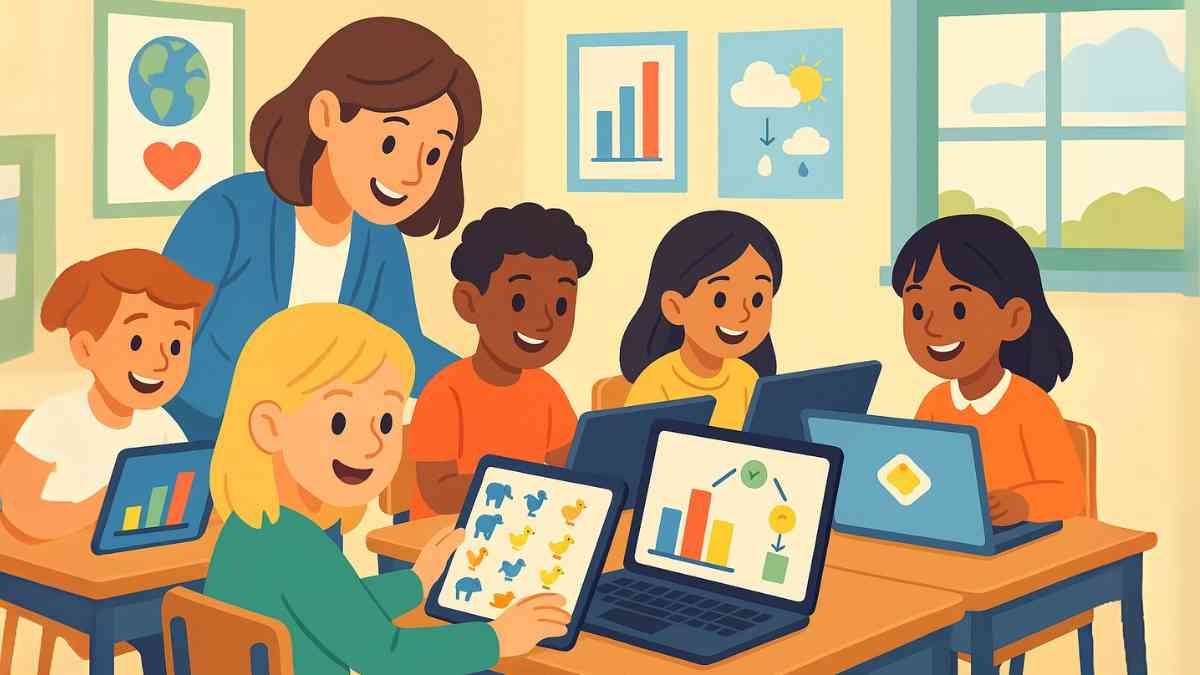J2e Data: Revolutionizing Data Handling in Primary Education

In today’s fast-evolving educational landscape, data literacy is becoming as essential as reading and math. As schools transition into digital learning environments, introducing data handling at an early age is critical. One educational tool that stands out in this regard is J2e Data. Developed by Just2easy, J2e Data is designed to empower young students by making data analysis accessible, engaging, and curriculum-aligned. This article explores how J2e Data is transforming primary education and why it deserves a prominent place in classrooms.
What is J2e Data?
J2e Data is a suite of intuitive, cloud-based data handling tools created specifically for students aged 5 to 14. Its interactive platform allows students to explore databases, pictograms, charts, and branching logic without needing any prior technical knowledge. Unlike traditional spreadsheet tools, J2e Data is visually driven and uses a child-friendly interface, ensuring students remain engaged while learning complex data concepts.
The platform is hosted on J2launch, Just2easy’s integrated learning environment. With its drag-and-drop simplicity and colorful visual elements, J2e Data encourages young learners to think analytically and make data-driven decisions from a young age.
Key Features of J2e Data
1. Pictograms and Simple Charts
Pictograms are the starting point for students in Key Stage 1 (KS1). They allow children to represent data visually using familiar images. As students grow, J2e Data introduces more complex chart types, including bar charts, pie charts, and line graphs. These tools help students understand trends, comparisons, and data relationships.
2. Branching Databases
Branching databases use a question-based decision tree model to help students sort and categorize information. By asking yes-or-no questions, learners create paths that lead to specific results. This feature not only builds logic and classification skills but also serves as an introduction to computational thinking.
3. Full Database Tools
J2e Data includes a powerful, easy-to-use database tool that teaches students how to define fields (such as text, number, image, and Boolean), input records, and use forms. This feature is perfect for Key Stage 2 (KS2) and Key Stage 3 (KS3) students, as it introduces them to real-world data management techniques.
4. Data Sorting and Filtering
Students can apply sorting and filtering tools to analyze the data they have entered. These tools mimic those found in professional database software, but are simplified for educational use. They help students discover patterns and answer specific questions using their datasets.
5. Interactive Charts and Graphs
J2e Data allows students to convert raw information into visual representations instantly. The platform supports customizable graphs that update dynamically when the underlying data changes. This real-time feedback loop enhances comprehension and keeps students engaged.
Educational Benefits of J2e Data
Enhancing Critical Thinking
By working with real data, students learn how to ask meaningful questions and interpret results. J2e Data strengthens analytical thinking, logical reasoning, and the ability to draw conclusions based on evidence.
Encouraging Independent Learning
Because the platform is designed to be intuitive and self-guided, students can explore independently. The drag-and-drop interface enables learners to experiment with data structures and see immediate outcomes from their actions.
Fostering Collaboration
Teachers can set up shared projects, allowing multiple students to contribute to a single database. This collaborative approach promotes teamwork, communication, and the sharing of ideas.
Supporting the Curriculum
J2e Data aligns with the UK national curriculum, particularly in Maths, Computing, and Science. It provides ready-made lesson plans and sample databases on various subjects, making lesson planning easier for teachers while ensuring educational relevance.
Cross-Subject Integration
The tool is versatile enough to be used in subjects beyond computing. For example:
- Science: Record plant growth over time and chart the results.
- Geography: Compare weather data from different regions.
- History: Create databases of historical figures and sort them by era, role, or location.
Why J2e Data Stands Out
Unlike generic tools like spreadsheets or data entry forms, J2e Data is designed specifically for children. It bridges the gap between playful learning and serious analytical skills, providing an age-appropriate introduction to concepts that will be essential in higher education and future careers.
Its seamless integration with other Just2easy tools like J2write and J2code makes it an ideal solution for schools aiming to adopt a unified digital learning environment. Teachers can embed J2e Data projects within broader thematic units, turning simple data tasks into comprehensive learning experiences.
Real-World Applications in the Classroom
Data Handling Project: Animal Classification
A KS1 teacher might use the branching database tool to help students classify animals. Each question in the decision tree helps students think about animal characteristics (e.g., “Does it have fur?”). Students learn not only science facts but also how to structure logical questions.
Climate Graphs in Geography
Students in KS2 could collect weather data over several weeks and enter it into J2e Data. By converting their information into line graphs, they can compare weather patterns and discuss climate differences between regions.
Surveys and Opinions in PSHE
A classroom survey about favorite school lunches can be turned into a database and visualized through pie charts. This gives students a voice and teaches them about gathering and interpreting opinions respectfully and objectively.
Teacher Support and Resources
J2e Data comes with extensive teacher support, including:
- Sample databases on topics like countries, sports, animals, and historical figures.
- Pre-built lesson plans tied to curriculum goals.
- Instructional videos to assist with classroom implementation.
- Assessment guides for evaluating student progress.
These resources reduce preparation time for educators while ensuring learning outcomes are met efficiently.
Accessibility and Inclusivity
J2e Data is web-based and compatible with multiple devices, including tablets and laptops. Its design considers accessibility, supporting learners with different needs. Visual cues, color coding, and easy navigation make it suitable for students with learning difficulties or language barriers.
Preparing Students for a Data-Driven Future
Today’s students are tomorrow’s analysts, developers, scientists, and entrepreneurs. Data literacy will be a cornerstone skill in the workforce of the future. J2e Data provides a solid foundation, helping students:
- Understand how data works.
- Analyze trends and patterns.
- Communicate findings effectively.
It transforms abstract concepts into hands-on, practical skills that stay with students for life.
Conclusion
J2e Data isn’t just a classroom tool; it’s a gateway to lifelong learning and analytical thinking. By making data handling approachable and engaging, it empowers young minds to explore, question, and understand the world around them. For schools seeking to nurture digital competence and analytical acumen in their students, J2e Data stands as an indispensable resource.
As education continues to embrace digital innovation, tools like J2e Data will shape the next generation of thinkers, problem-solvers, and informed citizens. Embracing it today ensures that our students are well-equipped for the challenges and opportunities of tomorrow.



